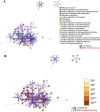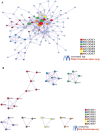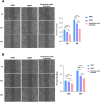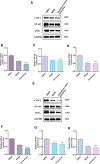Network pharmacology and anticancer mechanism study of Dendrobium nobile dendrobine in the treatment of colorectal cancer
- PMID: 39692955
- PMCID: PMC11655935
- DOI: 10.1007/s12672-024-01641-6
Network pharmacology and anticancer mechanism study of Dendrobium nobile dendrobine in the treatment of colorectal cancer
Abstract
Objective: This study aims to explore the potential targets and anticancer mechanisms of dendrobine from Dendrobium nobile in the treatment of colorectal cancer through network pharmacology, and to experimentally validate its specific effects.
Methods: Initially, potential targets of dendrobine were identified using the ITCM Traditional Chinese Medicine database, while colorectal cancer-related genes were obtained from the NCBI Gene database, with the intersection of these datasets taken for further analysis. Functional enrichment analysis was conducted using the Metascape database, and a protein-protein interaction (PPI) network was constructed. Additionally, cell culture, cell proliferation assays, and wound healing assays were performed. The Wnt/β-catenin and NF-κB/COX-2/PGE2 signaling pathways were analyzed using PCR and Western blot experiments.
Results: The PPI network constructed from 152 intersecting genes revealed that these genes play crucial roles in processes such as cell proliferation, apoptosis, and signal transduction. Cell-based assays demonstrated that dendrobine significantly inhibits the proliferation and migration of colorectal cancer cells. Furthermore, PCR and Western blot results indicated that dendrobine suppresses colorectal cancer cell proliferation and migration by modulating the Wnt/β-catenin and NF-κB/COX-2/PGE2 signaling pathways.
Conclusion: Dendrobine exhibits significant anticancer potential against colorectal cancer by regulating the Wnt/β-catenin and NF-κB/COX-2/PGE2 signaling pathways, providing a theoretical foundation and experimental evidence for its therapeutic application in colorectal cancer.
Keywords: Colorectal cancer; Dendrobium nobile dendrobine; NF-κB/COX-2/PGE2 signaling pathway; Network pharmacology; Wnt/β-catenin signaling pathway.
© 2024. The Author(s).
Conflict of interest statement
Declarations. Ethics approval and consent to participate: No clinical patient study is conducted in this article, and no ethical statement is required. Consent for publication: Not applicable. Competing interests: The authors declare no competing interests.
Figures













Similar articles
-
Erianin, the main active ingredient of Dendrobium chrysotoxum Lindl, inhibits precancerous lesions of gastric cancer (PLGC) through suppression of the HRAS-PI3K-AKT signaling pathway as revealed by network pharmacology and in vitro experimental verification.J Ethnopharmacol. 2021 Oct 28;279:114399. doi: 10.1016/j.jep.2021.114399. Epub 2021 Jul 8. J Ethnopharmacol. 2021. PMID: 34246740
-
Exploring the mechanism of dendrobine in treating metabolic associated fatty liver disease based on network pharmacology and experimental validation.Hereditas. 2024 May 16;161(1):17. doi: 10.1186/s41065-024-00322-2. Hereditas. 2024. PMID: 38755697 Free PMC article.
-
Involvement of the Sch9/Rim15/Msn2 signaling pathway in the anti-aging activity of dendrobine from Dendrobium nobile Lindl. via modification of oxidative stress and autophagy.Chin Med. 2023 Sep 5;18(1):111. doi: 10.1186/s13020-023-00827-4. Chin Med. 2023. PMID: 37670345 Free PMC article.
-
Age-dependent dendrobine biosynthesis in Dendrobium nobile: insights into endophytic fungal interactions.Front Microbiol. 2023 Dec 8;14:1294402. doi: 10.3389/fmicb.2023.1294402. eCollection 2023. Front Microbiol. 2023. PMID: 38149273 Free PMC article.
-
Two new alkaloids from Dendrobium nobile Lindl. exhibited neuroprotective activity, and dendrobine alleviated Aβ1-42 -induced apoptosis by inhibiting CDK5 activation in PC12 cells.Drug Dev Res. 2023 Apr;84(2):262-274. doi: 10.1002/ddr.22030. Epub 2023 Jan 19. Drug Dev Res. 2023. PMID: 36658700
References
-
- Baidoun F, Elshiwy K, Elkeraie Y, et al. Colorectal cancer epidemiology: recent trends and impact on outcomes. Curr Drug Targets. 2021;22(9):998–1009. - PubMed
-
- Klimeck L, Heisser T, Hoffmeister M, et al. Colorectal cancer: a health and economic problem. Best Pract Res Clin Gastroenterol. 2023;66: 101839. - PubMed
Grants and funding
- QZYY-2024-043/Guizhou Provincial Administration of Traditional Chinese Medicine Research Project on Traditional Chinese Medicine and Ethnic Medicine Science and Technology.
- QZYY-2024-043/Guizhou Provincial Administration of Traditional Chinese Medicine Research Project on Traditional Chinese Medicine and Ethnic Medicine Science and Technology.
- QZYY-2024-043/Guizhou Provincial Administration of Traditional Chinese Medicine Research Project on Traditional Chinese Medicine and Ethnic Medicine Science and Technology.
- QZYY-2024-043/Guizhou Provincial Administration of Traditional Chinese Medicine Research Project on Traditional Chinese Medicine and Ethnic Medicine Science and Technology.
- QZYY-2024-043/Guizhou Provincial Administration of Traditional Chinese Medicine Research Project on Traditional Chinese Medicine and Ethnic Medicine Science and Technology.
- QZYY-2024-043/Guizhou Provincial Administration of Traditional Chinese Medicine Research Project on Traditional Chinese Medicine and Ethnic Medicine Science and Technology.
- QZYY-2024-043/Guizhou Provincial Administration of Traditional Chinese Medicine Research Project on Traditional Chinese Medicine and Ethnic Medicine Science and Technology.
- QZYY-2024-043/Guizhou Provincial Administration of Traditional Chinese Medicine Research Project on Traditional Chinese Medicine and Ethnic Medicine Science and Technology.
- 2023-3-30/Guizhou Province Qianxinan Prefecture Science and Technology Plan Project
- 2023-3-30/Guizhou Province Qianxinan Prefecture Science and Technology Plan Project
- 2023-3-30/Guizhou Province Qianxinan Prefecture Science and Technology Plan Project
- 2023-3-30/Guizhou Province Qianxinan Prefecture Science and Technology Plan Project
- 2023-3-30/Guizhou Province Qianxinan Prefecture Science and Technology Plan Project
- 2023-3-30/Guizhou Province Qianxinan Prefecture Science and Technology Plan Project
- 2023-3-30/Guizhou Province Qianxinan Prefecture Science and Technology Plan Project
- 2023-3-30/Guizhou Province Qianxinan Prefecture Science and Technology Plan Project
LinkOut - more resources
Full Text Sources
Research Materials
